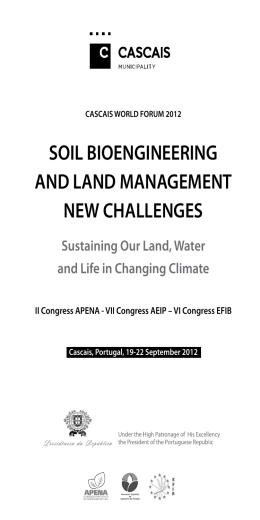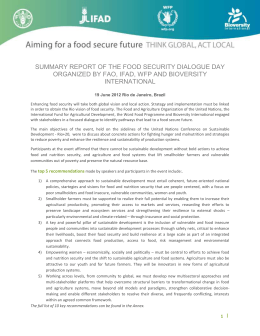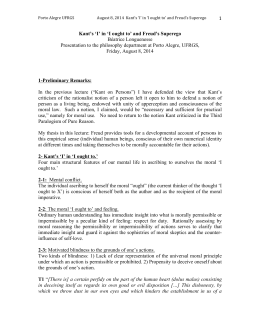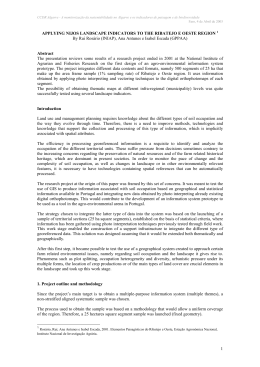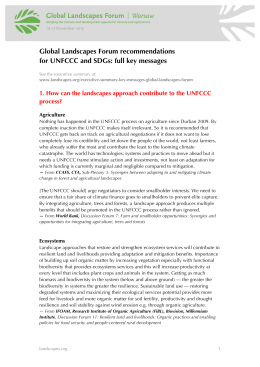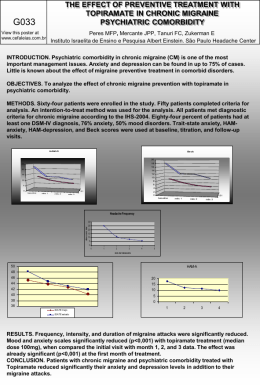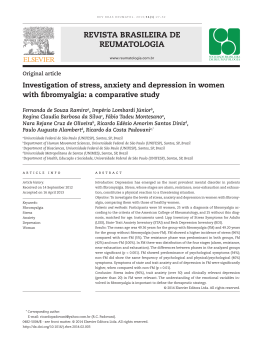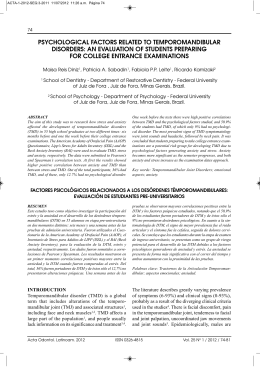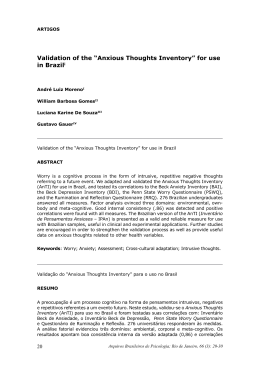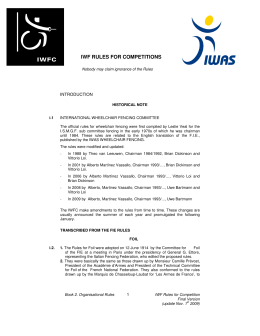BERLINCK, Manoel Tosta - Landscape and existence Abstract The recognition that there is landscape in the mental apparatus is nothing new, but the topic has not been adequately studied. It is generally understood today that forgetting does not mean that memory has been destroyed or annihilated. A corollary assumption has thus been posited that nothing that has ever been present in mental life can perish, and that everything is preserved in some way. Under favorable circumstances, therefore, anything can return to the surface. This article suggests that the unconscious memory takes the form of landscapes organized according to structural defense mechanisms. Every structured psychopathological expression is thus organized in the form of a landscape that has its own dynamics. Key words: fundamental psychopathology, landscape, existence, unconscious memory. Landscape: how it is made This landscape? It doesn't exist. Vacant space exists, to sow from retrospective landscape. The presence of the mountains, the imbaúba trees, the springs, what presence? Everything is later. Twenty years later, as in dramas. For the time being seeing does not see; seeing gathers fine fibers of paths, of horizons, and fails to note that it gathers them to one day weave tapestries which are photographs of unperceived visited land. The landscape is going to be. Now it's a blank that will be dyed green, brown or gray, but color doesn't hold to surfaces; it doesn't model. Stone is only stone as it slowly matures. And the water of this brook does not wet this naked body: it wets it later. Water is a project for living. Open the gate. It creaks. Indifferent. A silence-cow. Not even looking. One day this perfect silence-cow, this creaking will hit me, existing facing frontward, backward, to the side, so tangible. Someone at the side asks: What's wrong with you? And there's nothing except the gate-sound, the silent cow. Landscapes, country made of thinking about the landscape, in the creative spacitime distance, at the edge of engravings, documents, when things exist with violence more than we exist: they inhabit us and they look at us, stare at us. Contemplated, submissive, of them we are pasture, we are the landscape of the landscape. Carlos Drummond de Andrade In As impurezas do branco [The impurities of the blank], 1973 In his book Three forms of frustrated existence (1956) Ludwig Binswanger relates the following fragment of a clinical case: One Sunday during my afternoon visits I run into a patient by the name of Hae. He is over sixty years old and is a chronic schizophrenic (paranoid hebephrenic) who still conserves his intellectual faculties. He is serenely sitting at his table with a piece of cold tongue (left over from dinner) placed on his bald head. Surprised and amused, I ask what in the devil he is doing. In a very serious tone of voice, but with a slight but perspicacious twinkle in his eye he answers that the piece of tongue greatly relieves his stinging head. (p. 71) What we see in this scene is the question of the distance between the dead tongue/language that appeases and puts in order, providing structure and meaning to thought, and the living tongue/language that bubbles up and produces a stinging inside his head. All tongues, or languages, are dead/alive. Dead languages are assured by a structure, a vocabulary and semantics that give them their shared nature. If it were not for Latin, a dead language, Portuguese, French, Spanish, Italian, and even partially English, would have nothing to derive their existence from. Some languages do not derive from others, but they nevertheless evolve and derive from their own past. A dead language guarantees the communality proper to language. Living languages bubble up in the mind of each human being and are, in fact, each individual’s intimate personal expression. Like bubbles, they are born from carnal impressions and have a disorderly character proper to bubbles in water. They are somatic but appear in the mental sphere. Therefore, they present no distinction between soma and psyche. This important distinction, then, is between the living and the dead: to be spoken, a living language must be articulated with the structure of the dead language, thus making comprehension possible. The constantly problematic articulation between the dead and the living languages produces not only expressive discourse. It also gives order to the bubbling up of words, giving shared meaning to what is thought. Most human beings are able to contain the bubbling up and give it order and meaning. Some, like the poets, incessantly seek things that bubble up in the dead language. Insight – looking inside – is the perceiving of a bubbling up of language that takes place in the dead orderliness of the language itself. But as in the case described above, the absence of distance between the two languages does not always appear. The distance between the dead language, in its metonymic concreteness, and the living language, in its bubbling up, cannot be surpassed in this existence. Depending on the interests of the subject's so-called intellectual faculties, s/he can go in search of something (a dead language) that can give him or her consistent expression and enable reasonable manifestation. But this is not always possible, and this indicates the existence of a space, an irreducible distance. In other situations (Berlinck, Koltai and Canongia, 2001) the subject winds up inventing a miscegenated language of his or her own that can express errancy and the shadow of an unattainable dead language. When, in the irreducibility of distance, the subject described by Binswanger seeks an integration between a dead and a living language, he is faced with an impossibility, an irreducible splitting, where no dialectic takes place. But this subject shows an important peculiarity: he "conserves his intellectual faculties." That is, he has the possibility of integrating the dead and the living languages. He is able to give meaning and expression to both the dead language, in the figure of the cow's tongue on his bald head, and the living language, which he calls the ceaseless bubbling up of ideas. He is also able to express this paradox through an eccentric existence, which includes putting a tongue on top of his head. This is one of the manifestations of schizophrenic existence, and it reveals not only the existence of two tongues, or two languages, the dead and the living, that must be integrated if the subject is to seek an expression that is, at one and the same time, proper to the species and proper to singularity. His existence also reveals the impossibility of this integration and unilaterally exposes the irreducible distance between the dead and the living. In the case described by Binswanger, the irreducible distance is assured by the bone structure of the head and by hairless skin, the bald head. "It is as if the personality had disintegrated into separate complexes that no longer exercise mutual influence," as Jung once wrote to Freud (1993, p. 63). Thus, an insurmountable space arises between the living language, which is bubbling and chaotic, and the dead language, which is structured and ordered, and prevents or limits the subject’s shared existence. In this case there is a loss of vital contact with the reality of one's own language, and the subject seems immersed in utter apathy. Sometimes, as in this fragment from Binswanger, the subject gives the impression that he is talking not about himself, but about some third person, who is immersed in the bubbling of the language. Such subjects often refer to a "you" or to a "person" when referring to themselves. In these situations, the ego ceases to exist simply because the language lacks order. When the bubbling and disorganized language is articulated with the dead language, the Other becomes present, and this gives the subject the impression of belonging to a linguistic community. But when the articulation fails there is no community, no Other, and the world becomes pure feeling. Gilles Deleuze (1974), referring to a world with no other, no one else, calls attention to the organizing character of this presence: The first effect of the other, someone else, is that around each object I perceive or each idea I think, there is the organization of a marginal world, an arch, a background from which other objects or other ideas can stand out according to laws of transition that regulate the passage from one to the other. I look at an object, then I look away. I let my focus return to the background at the same time that, in my perception, a new object stands out from the background. If this new object does not hurt me or does not shock me with the violence of a projectile (as when we bump into something we have not seen), it is because the first object had a wide margin where I immediately felt the pre-existence of the next objects, of a whole field of virtualities and potentialities that I already knew could be actualized. This type of knowledge or feeling of marginal existence is only possible through someone else. Someone else is for us a powerful factor of distraction, not only because this other ceaselessly disconcerts us and pulls us out of our intellectual thinking, but also because the other's simple possibility of appearing is enough to cast a vague flash of light on an enormous number of objects that are located at the margin of our attention but that can, at any moment, become the center of it. (p. 314-15) Then Deleuze asks (1974): What happens when there is no other, no "someone else," in the structure of the world? When there is only the brute opposition between the sun and the earth, unbearable light and total darkness: the summary law of all or nothing. The known and the unknown, the perceived and the unperceived confront one another in absolute terms, in a struggle without nuances. [...] It is a raw and black world with neither potentialities nor virtualities: it is the category of the possible that has crumbled. Instead of relatively harmonious shapes that stand out from a background and then return according to an order of space and time, there is nothing more than abstract, luminous and crushing lines, nothing more than a rebellious and sucking non-background. Nothing but Elements. The non-background and the abstract line have replaced the modeled and the background. Everything is implacable. Having ceased to extend and bend toward one another, the objects arise threateningly. We then discover evils that are no longer those of man. It might be said that each thing, having abdicated its model, is reduced to its hardest lines, and beats and batters us from behind. We feel the absence of someone else when we trip and there is an instant when the stupefying speed of our gestures becomes clear. (p. 316) Contardo Calligaris (1989) brings up the question of the nature of a psychotic structure outside a psychotic crisis, and the opposite question, what is the organization of a subject structured in psychosis but who has never had a crisis. He then described a fragment of a case of a young man approximately 30 years of age who "was available for anything, not in the sense of docility or that it would have been easy to manipulate him, but in the sense that, for him, any road and any direction were possible directions, possible roads" (p. 11). On the next page, Calligaris adds that, "There was nothing in his behavior that might indicate any impossibility or particular difficulty in functioning in a common phallic register. He was able to refer to phallic significations distributed in a super-phallic ambience, like the social environment of the high commercial bourgeoisie of Paris" (p. 12). Calligaris then concludes that: If I bring up this example, which was instructive for me in all its aspects, it was to begin thinking about what a subject whose horizon of meanings was not organized around a possible unit of measurement might be like. He was a subject living in a world where meaning exists, but in the final analysis, all the meanings are meanings in themselves. They are not measured in terms of a meaning that distributes the meanings of the world. [...] This subject is eminently errant, in the sense of errancy, not of errors. He is a subject who can make mistakes, in the sense of going about the world and its pathways. [...] His world consists of a horizon of meanings that are not organized around a central meaning that can organize all the others. As a consequence of this position, the subject has to err. But to err not in the search for something that could be found as final meaning, nothing at all like that. This would be closer to "neurotic erring" than to "psychotic erring." To err because there is no place from which we can measure the meaning of what we are doing. It is thus clear that the only thing that remains to do is to take all the roads. What remains is an infinite path, a path with nowhere to stop. It might be noted that this is an infinite path, but an infinite that is not idealized like the infinite of a search. It is the infinite of a map, which is quite a different thing. [It could be seen as] the infinite of a map that might be the map not of the earth, but of the sky, a map of the infinite. (pp. 12-13) The errancy, then, is an eccentric mode of existence in a landscape without hierarchies, with nothing that stands out, and governed only by the free association of ideas. These ideas, having meaning and direction, have the same value as any other ideas, that is, any other meaning and direction. This mode of existence is far from the poet who seeks to integrate the bubbling of the living language into the dead language to give it value: the value of poetic existence. In the errancy of schizophrenic existence the subject freely associates without submitting to the value inherent in the free association formulated by the fundamental rule of psychoanalytic clinical work. In a discourse without hierarchies, without values, it would be useless to formulate the fundamental rule. In the case of neurotic existence, the rule refers largely to an ideal to be sought, and imposes a hierarchy that reveals the resistance that is to be interpreted. Numerous clinicians call attention to the way each subject expresses his or her existence in space, constituting landscapes. But no psychopathology of intrapsychic space is known. Nevertheless, and this is the hypothesis of this article, each psychopathological manifestation – conversion hysteria, anxiety hysteria, perversion, obsessional neurosis, melancholia, schizophrenia, paranoia – appropriates space in a particular way, revealing structured dynamics, that is, a specific landscape that inhabits the space. The psychopathologist Binswanger, who dedicated himself to observing and reflecting on the nature and dynamics of space as an expression of existence, in "Dreams and existence" (2002), describes numerous oneiric manifestations where objects and subjects move along a central vertical axis, rising to the heights and descending to the ground. This admirable essay by Binswanger begins as follows: During surrender or impassioned love, what we expected may suddenly disappoints us and the world may become so "other" that it completely uproots us and takes away the ground under our feet. Then, later, after we have found a foothold, we go back to those moments in our thoughts and say 'We fell from heaven as if we were struck by lightning.' It is in fact through such words that we express our experience of disappointment and confusion, through a poetic metaphor, not at all produced by the imagination of some poet, but springing from the spiritual fatherland that belongs to us all: our language. Language is what "poetizes and thinks" for everyone, long before the individual himself begins poetizing and thinking. [...] This essential character rests in the deepest structures of our existence, where all living spiritual forms and living spiritual contents, still united, await the burning ray that will separate them. When a sudden disappointment makes us "fall from heaven" we really do fall, but it is not a purely physical fall, nor anything that is (analogically or metaphorically) its imitation or derivation. We can say, more exactly, that the essence of this sudden disappointment and this terror is nothing more than the fact that the harmony with the outside world and with the world of the other, a harmony that until then had been our support, has taken a jolt that made it totter. At such a moment our existence is truly affected, pulled off its support in the world and thrown back on itself. Until we can once again find a solid foothold in the world our entire existence will be bent toward meaning, which is the direction of tripping, sinking, falling. If we give the name "form" to this general direction of meaning, and if we call sudden terror "contents," we will see that even here the two are only one. (pp. 417-18) These clinical observations would be enough to turn our attention to landscape as the sphere of psychic existence. More than this, however, they show that, in every psychopathological manifestation, there can be a certain way for the subject to occupy it and move about, thus setting up a landscape. So, as Binswanger suggests, the schizophrenic is unable to integrate the dead and the living languages into a single space because he lives a split existence that lacks a phallic reference. The schizophrenic inhabits the space in an errant existence, as Calligaris so accurately describes. He or she lives in errancy without the search for a phallic reference, without reference to a dead language that would give him the support he needs to live his own proper and particular living language. The rising and falling movement that Binswanger observed is typical of melancholia and reveals a structured appropriation of space in another existence, different from that experienced by the schizophrenic. In melancholia the intrapsychic landscape is rarely organized into a horizontal axis without hierarchies or without any possibility for articulation among the objects, as is the case in schizophrenia. The melancholic suffers from articulation, since he or she lives in a world, a landscape, of heights and chasms, where distances have a vertical meaning. The catastrophe or upheaval that, in the Freudian myth, pulled the hominoids out of a nirvanic state and threw them into the sphere of pleasure, creating specifically human sexuality, occurred with the introduction of space as landscape. Space and landscape are very primal components of the inaugural narcissism of the species. In fact, the phylogenetic myth of psychoanalysis lets us affirm that the first human manifestation took place in an atmosphere of crisis, that is, in an unspecified surrounding space that assured existence. It was in this environment, in a crisis caused by the glacial catastrophe, that the animal that was yet to become human, lost contact with its object of satisfaction and with sexual regularity. This cataclysm, this upheaval, produced a narcissistic retreat of the libido and revealed an irreducible distance between the object of satisfaction and the organ. This libidinal retreat revealed a distance that had until then been imperceptible in the natural order of things, produced increased energy in the organ and demanded a discharge in the organ taking shape. All the elements of the landscape can be found for the first time in the figure of conversion (not hysteria of conversion but simply conversion as existence). There is a distance between organs that creates a topos, thai is, a necessary location in reference to space, a place for existence, and there is a chôra (Fédida, 1992), that is, “a place of places, a place that makes possible the temporal movements of discources (less in place than what may seem!), in short, a place that, in negative, separates the mythical from the logical. This place of places – chôra – separates two memories and makes them co-exist. They are two inscriptions exclusively in the situation of speech" (p. 132). Topos and chôra determine the limits and dynamics of space and constitute the bases of the landscape. Topos, or place, is the guarantee of concrete existence, the space occupied by the organ. Chôra is the place of welcome, or reception. In this regard, it is the place of places. Freud's idea of body is constructed on the dynamics of these places, these sites, in space. He sees the body as a surface of organs (places, topos and chôra), all behaving like penises, that is, anxious to reproduce in the organ taking place (by conversion) (Berlinck, 2000). Conversion, then, is the prototype of the transference. It is an attempt to displace the excesses produced by the figure of the dead one (the object of satisfaction lost forever) that are deposited in the other in the name of existence. Freeing itself from the excess, the organ displaces energy to another organ and creates a new equilibrium in the space we call bodily. This bodily space, comprised of a surface of organs in conversion, that is, converging, is the place of the psychic apparatus, a narcissistic organization of the void, the landscape proper to subjectivity. Freud gave the name of neurosis, or conversion hysteria, to the repetition and patterning of conversion. It is therefore a movement governed by death, which unceasingly seeks an equilibrium that has been lost forever. This repetitious and pattern-like movement takes place in the space between the organs and in the space of the organs, constituting a form of spatial existence that precedes the psychic apparatus and speech, that is, expression through words. Like all neuroses, conversion neurosis is an expressive appropriation of the space of bodily existence that, as Freud so clearly observed, prescinds from the word since it is prior to it, but already comprised of objects, a world without someone else, that Freud calls self-erotic. The glacial catastrophe that caused the loss of contact with the object of satisfaction and with sexual regularity caused pain and a feeling of being unattached, which Freud called helplessness. One day a patient came to my office seeking treatment and complaining of an intense feeling of being unattached. Long ago he had immigrated from a European country, and eventually married a Brazilian wife and had Brazilian children. When he came to see me, his children had already grown up and were living in his native country, leaving him and his wife alone in Brazil. According to the patient, his wife is of "simple and of limited origin" and is unable to make contact with his world. Nor can she offer him any support beyond the fact that she is extremely pragmatic, very “earthy,” in his words. Unable to return to his native country, this man likens himself to an asteroid drifting through space without direction and without destination. The resources he had found to sustain him – his profession, characterized by a constant search for information about reality, and his very pragmatic and earthy wife – are not enough to give him a feeling of belonging or relevance in the world. Without friends and with his only relatives very far away, he feels he is aging and alone in the world. He is without a foothold, floating in space without a place, with no topos and no chôra. Freud’s concept of helplessness, brilliantly studied by Pereira (1999), is intimately associated with terror, panic and anxiety. In moments of such distress, human beings must seek a protective and receptive place where they can live out their depression, that is, the slowing down of their vital functions (Berlinck and Fédida, 2000) that guarantee them an existence threatened by scarcity. The reduction and slowing down of the vital functions, proper to depression, call for an accepting and protective place where human beings can live out their existence. This is an experience in time when major changes can take place. This receptive and providing space, which some call environment, is the unspecific surroundings that support life. There is a territory, a space marked by borders, or boundaries, between the inside and the outside. This space is considered the home, a place for food and rest. There helpless humans can relax and give in to the erotic of sleep (Pereira, 2003), that is, the time needed for hibernation, a state of depression needed to replace the energy spent in the struggle for survival. This space is also where the psychic apparatus is constituted as a narcissistic organization of the void. The terror, panic and anxiety are related to space, and emerge at the moment the subject leaves this state of depression where dreams and the primitive psychic objects predominate. Terror occurs with the sudden perception of the nearness of the other, before the psychic apparatus has been inhabited by objects. Terror occurs in autism, which is a state of self-eroticism without Eros (Bleuler, 1993) that characterizes the most primitive aspects of the psychic apparatus (Berlinck, 1999). Panic, an acute form of anxiety, is always related to a threatening space where there is no persecutory object, as there is in paranoia. Pereira (1999) observes that one of the first forms of panic described by psychiatry was agoraphobia. "The etymology of the word ‘anxiety’ refers to a contraction of vital space felt as oppressive and suffocating (it should be recalled that the Latin verbs ango and anxio mean, squeezing, physical constriction, and torment)," Pereira writes elsewhere (2002, p. 105). Terror and panic reveal a world still without objects where the other emerges unexpectedly, with no driverelated bond. The drive, in turn, being energy that has a physical, or bodily source, is directed toward objects and constitutes them, moving through the empty space of the psychic apparatus. The libido is no longer manifest in conversion, and takes on the name of drive, as it makes connections between organs and objects that inhabit the psyche. It would be well to remember, however, that before the drive exists there is no object, even if images of things appear and disappear in the sphere of the psychic apparatus, in primal bubbling up. The drive is what gives existence to the object and roots it in the space of the psychic apparatus. Garcia de Araújo (2002) notes that anxiety and care, seen on the horizon of temporality, constitute the nucleus of Heidegger's conception of existence. Anxiety can thus be understood as the original experience of human time, lived time, the basis of existence itself. This time is not something outside of us. "We are it," or we "are part of it.” It places us before being and not-being – death, the nothing. We are thus continually confronted by anxiety. So anxiety has its genesis in our "original condition," the condition that defines the "find oneself there," of the Dasein. This "there" means the "world" (the world of existence, not the world of the physis) and has to do with a "fundamental willingness," a "feeling of a situation" of helplessness and strangeness, the source of all particular feelings. (ibid., p. 125) For Heidegger, in the final analysis, anxiety is anxious about the nothing, that cannot be seen anywhere. "Anxiety is only the assertion of a precariousness and a radical contingency (be “thrown” there), a situation beyond which nothing exists. Also, our existence is never realized, or carried out. It is always in play, always to be done. For this reason, it is cared for. It is a "task of being" (ibid., p. 125). Anxiety neurosis arises due to the repetition and patterning of anxiety and becomes evident in situations where existence is no longer threatened. Anxiety neurosis allowed Freud to discover psychic trauma and describe it for the first time in "Project for a scientific psychology," in the section he entitled Proton Pseudos. Emma (a number of Freud's patients bore this name) was a lovely young woman who came to him because she suffered from a phobia of boutiques. Whenever Emma tried to go into a boutique she was overtaken by a feeling of panic that made her retreat. The reader can well image the predicament of a lovely young woman, in late-19th-century Vienna, during the period known as the Belle Epoque, afraid of going into boutiques. This was definitely a very serious symptom. Listening to Emma's story of fear, Freud discovered that when she was about four years old she had frequented a pastry store near her home. The pastry maker not only made and sold delicious pastries that Emma loved. He also liked to squeeze Emma’s genitals, with a smile, every time the girl went in to buy pastries. Emma, of course, would get very aroused and liked both the pastries and the squeezes. Time went by and Emma grew into a beautiful and lively young woman, and had forgotten completely about the episode with the pastry maker. One day, going into a boutique, she was received by a salesman with a smile on his face. That smile, like the smile of the Cheshire Cat in Alice in Wonderland, became disconnected from the salesman's own bodily surface and floated through space to land on the face of the pastry maker of her childhood. This voyage was almost instantaneously accompanied by the awareness of the resignifications of the childhood scenes, now impregnated by civilized sexual morals. This recollection, accompanied by its resignifications, produced a shock of anxiety in Emma, and she retreated in panic. This episode shows that anxiety neurosis, triggered off by a trauma, is a patterned repetition of something that took place somewhere else, sometime in the past, and that the neurosis must be actualized and resignified in order to appear. Besides being temporal operations, actualization and resignification are the scene, or landscape, where these dynamics take place. By observing these spatial dynamics the clinician can construct a picture, a landscape, that will provide a diagnosis about mental pathos. Free-floating attention, which is an ethical commitment, is also a state of naturalistic observation developed in an exemplary way in German culture as of the 18th century, having influenced not only Freud's masters, but Freud himself. The recognition that there is a landscape in the mental apparatus is nothing new. Freud himself, in "Civilization and its discontents" (1930/1969) recognizes its existence when he discusses the question of preservation in the sphere of the mind. He says: The subject has hardly been studied as yet; but it is so attractive and important that we may be allowed to turn our attention to it for a little, even though our excuse is insufficient. Since we overcame the error of supposing that the forgetting we are familiar with signified a destruction – that is, the annihilation of the memory-trace – we have been inclined to take the opposite view that, in mental life, nothing which has once been formed can perish – that everything is somehow preserved and that in suitable circumstances (when, for instance, regression goes back far enough) it can once more be brought to light. (p. 256) Several pages farther ahead, he adds: [W]hat is past in mental life may be preserved and is not necessarily destroyed. It is always possible that even in the mind some of what is old is effaced or absorbed – whether in the normal course of things or as an exception – to such an extent that it cannot be restored or revivified by any means; or that preservation in general is dependent on certain favorable conditions. It is possible, but we know nothing about it. We can only hold fast to the fact that it is rather the rule than the exception for the past to be preserved in mental life. (p. 259) The preservation or not of this vast landscape, which includes everything that has ever been experienced not only by the subject, but also by the species, is the problem of memory. But it is also the problem of the defense mechanisms that protect humans from their own memories. In human beings, the history of what has been experienced takes place through the psychopathological, that is, memory is the work of pathos, of what affects the human being and makes him or her suffer. Human beings protect themselves from pathos and memory when they dislodge, repress, refuse, deny, etc., and so forth, thus seeking to avoid suffering by creating the unconscious. By adopting the defense mechanisms as a way of life, human beings kill what is alive and creates a form of existence in a landscape built upon the mental defenses. This is the hypothesis of this article and its possible novelty: that the memory is organized in the mental apparatus as a landscape which is organized psychopathologically. That is, that psychopathology is inherent to the human mental apparatus. Understood in this way, the spatial dynamics of the psychic apparatus posit a question of the notion of freedom used by Freud and his followers. The fundamental rule supposes the freedom to say, but also to observe. Therefore, trying to say whatever comes to mind calls for observation without censorship, even though we know this is impossible. Not even the clinician expects this to happen. If it does, we would be dealing with an errancy of pointless chatter, that is, a clearly "schizophrenic" occupation of the mental space. The fundamental rule, then, serves not only to be disobeyed. It is also the psychoanalyst's resource to note the compulsion to repeat in the clinic. In other words, the compulsion to repeat is a repetitious and patterned way of occupying space, of living constitutively in the landscape. Movement in the mental space can be seen in the patient's discourse, and this lets the clinician recognize resistance, which is the lack of freedom to displace in space. And since it is repetitious, this resistance is a poor dwelling in the landscape. In the final instance, by declining the fundamental rule, psychoanalysis seeks a freedom that cannot be fully attained. But the dream – something that does not exist and cannot be attained by the subject (which Freud defined as controlled psychosis) continues as the paradigm for mental sanity. References: Andrade, Carlos Drummond de. Poesia completa. Rio de Janeiro: Nova Aguilar, 2002. Araújo, José Newton Garcia de. Angústia e cuidado (pp. 117-138). Em Besset, Vera Lopes (org.). Angústia. São Paulo: Escuta, 2002. Berlinck, Manoel Tosta; Koltai, Caterina e Canongia, Ana Irene. Esquizofrenia e miscigenação. Revista Latinoamericana de Psicopatologia Fundamental, vol. IV, no. 4, pp. 11-29, dezembro de 2001. Berlinck, Manoel Tosta. Psicopatologia fundamental. São Paulo: Escuta, 2000. Berlinck, Manoel Tosta and Fédida, Pierre. A clínica da depressão: questões atuais. In Berlinck, Manoel Tosta. Psicopatologia Fundamental. São Paulo: Escuta, 2000. Berlinck, Manoel Tosta. Autismo, paradigma do aparelho psíquico. Estilos da Clínica. Revista sobre a Infância com Problemas, vol. IV, no. 7, pp. 30-42, 2º. semestre de 1999. Binswanger, Ludwig. Tres formas de la existencia frustrada. Exaltación, excentricidad, manerismo. Trad. de Edgardo Albizu. Buenos Aires: Amorrortu, 1956. Binswanger, Ludwig. O sonho e a existência. Natureza Humana, vol. 4, no. 2, pp. 417-49, julho-dez. 2002. Bleuler, Eugen. Demencia precoz. Buenos Aires: Lúmen, 1993. Calligaris, Contardo. Introdução a uma clínica diferencial das psicoses. Porto Alegre: Artes Médicas, 1989. Deleuze, Gilles. Michel Tournier e o mundo sem outrem. Em Lógica do sentido (pp. 311-30). Trad. de Luiz Roberto Salinas Fortes. São Paulo: Perspectiva, 1974, Fédida, Pierre. Nome, figura e memória. A linguagem na situação psicanalítica. Trad. de Martha Gambini e Claudia Berliner. São Paulo: Escuta, 1991. Freud, Sigmund (1930). Civilization’s and its discontents (pp.243-340). In the Penguin Freud Library. Translation edited by James Strachey. London: Penguin Books, 1955. V. 12. McGuire, William (org.). Freud/Jung – correspondência completa. Trad. de Leonardo Fróes e Eudoro Augusto Macieira de Souza. Rio de Janeiro: Imago, 1976. Pereira, Mário Eduardo Costa. Pânico e desamparo. São Paulo: Escuta, 1999. Pereira, Mário Eduardo Costa. A insônia, o sono ruim e o dormir em paz: a “erótica do sono” em tempos de Lexotan. Revista Latinoamericana de Psicopatologia Fundamental, vol. VI, no. 2, pp. 126-44, junho de 2003. Pereira, Mário Eduardo Costa. Sim ou não: a angústia e a voz do Outro (p. 105-116). Em Besset, Vera Lopes (org.), Angústia. São Paulo: Escuta, 2002. * This article has been originally published in Portuguese in Psicologia Clínica (Dept. of Psychology of the Catholic University of Rio de Janeiro).
Download
